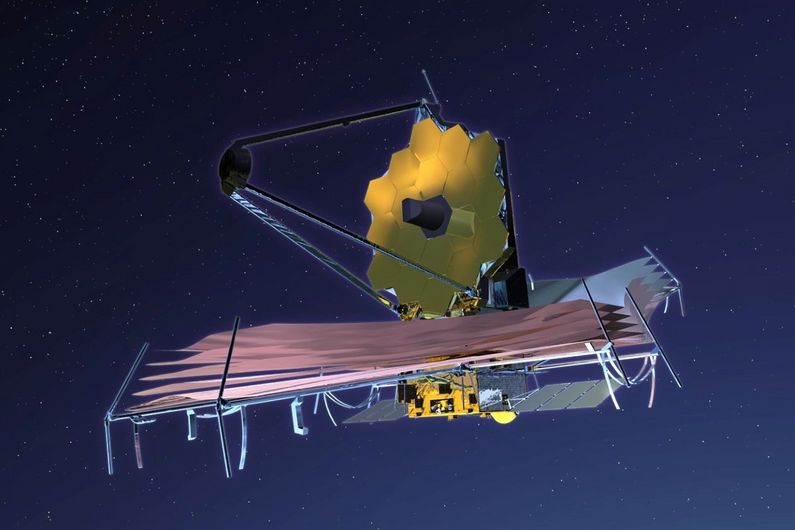James Webb Space Telescope: beginning to see the light
- Salle de presse
04/06/2022
- UdeMNouvelles
Our experts are available to talk about the next big step for the James Webb Space Telescope, which they helped design: its first images, set for release this summer.
The James Webb Space Telescope was launched in December with many sophisticated instruments aboard, including a Canadian guidance camera and scientific instrument co-developed by researchers at the Université de Montréal. Now those same experts, led by Professor René Doyon of the Department of Physics, are preparing for the telescope’s next big step: the release this summer of the first images it’s captured.
Experts in infrared instrumentation, the large team of astrophysicists at UdeM’s Institute for Research on Exoplanets (iREx) – professors, scientists and PhD students – are once again available to talk about the telescope’s progress to journalists (see below).
The result of an international collaboration between NASA, the European Space Agency and the Canadian Space Agency, the Webb Telescope orbits the Sun at 1.5 million kilometers from Earth and is the most important observatory for thousands of astronomers around the world. One of the Canadian instuments aboard is the Fine Guidance Sensor, or FGS. It helps orient the telescope in space to point to, track and take clear and precise images of celestial targets. The other Canadian component is the Near Infrared Imager and Slitless Spectrograph, or NIRISS; it will allow astronomers to study exoplanets, faraway galaxies and much more. UdeM’s scientists developed both instuments in collaboration with the Canadian Space Agency, the National Research Council of Canada, Honeywell Canada and other partners.
“The latest news is that we've just completed the mirror's ‘fine phasing,’ which means that the mirror is aligned, at least for one instrument, and the optics are working better than the original specifications, which is great news,” said Nathalie Ouellette, one of UdeM’s experts.
“This March we released an alignment evaluation image which represents the sharpest view in the infrared of that part of the sky ever taken, and we’re now aligning the mirror perfectly for all four of Webb's instruments,” she said. “We’re continuing to calibrate the scientific instruments, including the Canadian NIRISS. Canada's guiding camera, FGS, is working wonderfully – better than expected, even – and is being used throughout calibrations. The first images should be published this summer.”
Here is the full list of UdeM experts for the media to consult.
FGS/NIRISS instrument design; exoplanets; Webb mission overview
René Doyon, Professor, Department of Physics, Principal Investigator of the FGS/NIRISS instrument
Expertise: State-of-the-art astronomical instrumentation for various observatories, on the ground and in space. Brown dwarfs, exoplanets and young low mass stars. Search for extraterrestrial life.
Languages spoken: French, English
Press review of René Doyon
To contact him: rene.doyon(at)umontreal.ca
Observation and characterization of exoplanets; Hot Jupiter exoplanets
Romain Allart, postdoctoral researcher in the Department of Physics
Expertise: Detection and characterization of exoplanets. Velocimetry. Atmospheres and composition of exoplanets.
Languages spoken: French, English
To contact him: romain.allart(at)umontreal.ca
Design of the NIRISS instrument; brown dwarfs
Loïc Albert, researcher at the Department of Physics, NIRISS Instrument Scientist
Expertise: Astronomical observation and instrumentation. Brown dwarfs and rogue planets. Spectral characterization of exoplanets. Numerical simulations (noise effects).
Languages spoken: French, English
Press review of Loïc Albert
To reach him: loic.albert(at)umontreal.ca
Brown dwarfs; data reduction algorithms
Étienne Artigau, researcher in the Department of Physics
Expertise: Astronomical observation and instrumentation. Brown dwarfs and rogue planets. Velocimetry and spectroscopy of exoplanets.
Languages spoken: French, English
To reach him: etienne.artigau(at)umontreal.ca
Observation and characterization of exoplanets; Hot Jupiter exoplanets; rocky exoplanets
Björn Benneke, Professor, Department of Physics
Expertise: Detection and characterization of exoplanets. Atmospheres and climates of exoplanets. Search for extraterrestrial life.
Language spoken: English
Press review for Björn Benneke
To contact him: bjorn.benneke(at)umontreal.ca
Observation and characterization of exoplanets; spectroscopy
Antoine-Darveau Bernier, PhD student in the Department of Physics
Expertise: Detection and characterization of exoplanets. Transit spectroscopy. Velocimetry. Search for extraterrestrial life.
Languages spoken: French, English
To contact him: antoine.darveau-bernier(at)umontreal.ca
Exoplanet observation; transit spectroscopy
David Lafrenière, Professor, Department of Physics, Principal Investigator of the GTO NEAT program
Expertise: Astronomical instrumentation. Spectroscopy and spectrophotometry. Astronomical observations in the infrared. Atmospheres of exoplanets. Low luminosity stars, sub-dwarfs and brown dwarfs. Direct imaging. Search for extraterrestrial life.
Languages spoken: French, English
Press review of David Lafrenière
To contact him: david.lafreniere(at)umontreal.ca
Observation and characterization of exoplanets; the TRAPPIST-1 system
Olivia Lim, PhD student in the Department of Physics
Expertise: Detection and characterization of exoplanets. Habitable zone and search for extraterrestrial life. Velocimetry.
Languages spoken: French, English
To reach her: olivia.lim(at)umontreal.ca
Observation and characterization of exoplanets; Hot Jupiter exoplanets
Stefan Pelletier, PhD student in the Department of Physics
Expertise: Detection and characterization of exoplanets. Atmospheres and climates of exoplanets. Velocimetry. Search for extraterrestrial life.
Spoken languages: French, English
To reach him: stefan.pelletier(at)umontreal.ca
Exoplanet atmospheres; spectroscopy
Jake Taylor, postdoctoral researcher in the Department of Physics
Expertise: Transit spectroscopy. Exoplanet atmospheres and climates. Data reduction algorithms.
Language spoken: English
To contact him: jake.taylor(at)umontreal.ca
Direct imaging of exoplanets
Thomas Vandal, PhD student in the Department of Physics
Expertise: Detection and characterization of exoplanets. Velocimetry. Direct imaging of exoplanets. Interferometry.
Languages spoken: French, English
To contact him: thomas.vandal(at)umontreal.ca
Scientific and educational objectives & overview of the Webb mission; observation of galaxies
Nathalie Ouellette, Outreach Scientist for Webb in Canada, coordinator of the iREx (Institute for Research on Exoplanets), UdeM
Expertise: Formation and evolution of galaxies. Space exploration. Space astronomy. Science communication, education, public outreach.
Languages spoken: French, English
Press review of Nathalie Ouellette
To reach her: nathalie.ouellette.2(at)umontreal.ca
Media contact
-
Jeff Heinrich
Université de Montréal
Tel: 514 343-7593










